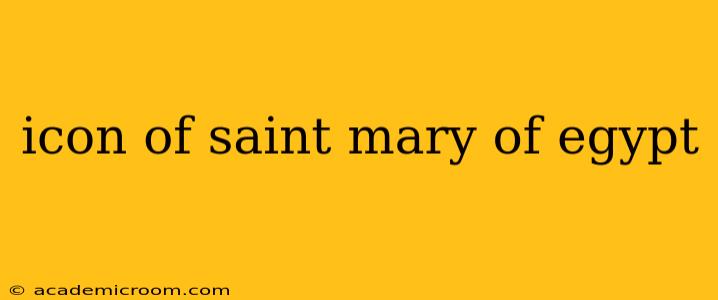Saint Mary of Egypt, a figure of profound repentance and spiritual transformation, holds a significant place in the Orthodox Christian tradition. Her life, marked by early sin and later profound holiness, is visually represented in iconic art, often conveying the multifaceted aspects of her journey. This exploration delves into the iconography of Saint Mary of Egypt, examining the common symbolic elements and variations found in her depictions.
What are the common features of Saint Mary of Egypt's icons?
Icons of Saint Mary of Egypt typically depict her as a penitent, often showcasing her transformation from a life of sin to one of profound spiritual devotion. Common features include:
-
Her age and appearance: While her exact age at the time of her conversion and death is debated, icons frequently portray her as an older woman, reflecting the years spent in the desert. Her face often shows signs of hardship and penitence, yet also radiates a serene inner peace. The lines etched on her face tell a story of a life lived fully, despite its troubled beginnings.
-
Her attire: Typically, she is depicted in simple, worn clothing, often rags, underscoring her renunciation of worldly possessions. The lack of elaborate garments emphasizes her humility and dedication to a life of spiritual poverty. The simplicity contrasts sharply with the opulent clothing often depicted in images of other saints.
-
Her setting: The desert landscape often forms the backdrop, highlighting her ascetic life and her isolation from societal distractions. The barren desert becomes a visual metaphor for her internal transformation and spiritual struggle. The wilderness, often portrayed with sparse vegetation and a vast sky, symbolizes her journey toward spiritual purification.
-
The presence of a desert animal: Sometimes, an animal companion, such as a wild ass or a lion, is shown near her, symbolizing God's protection and providence even in the harsh desert environment. This adds a layer of divine intervention and protection to her story of solitary penance.
-
The portrayal of her repentance: Her bowed head, downcast eyes, and overall posture often communicate her humility and deep repentance for her past sins. This aspect of the iconography emphasizes the transformative power of genuine remorse and the possibility of redemption.
What are some variations in the iconography of Saint Mary of Egypt?
While certain elements remain consistent, variations exist in the depictions of Saint Mary of Egypt across different artistic periods and regional styles:
-
Stylistic differences: The specific artistic style—Byzantine, Russian, or other—influences the icon's overall appearance, including the use of color, line, and composition.
-
Emphasis on specific aspects of her life: Some icons might focus on her early life, showing her as a young woman, while others highlight her later years of asceticism and spiritual attainment. The artist's choice emphasizes different aspects of her remarkable life story.
How is Saint Mary of Egypt depicted differently from other female saints?
Compared to other female saints often depicted in regal or more adorned attire, Saint Mary of Egypt's iconography emphasizes her humble and penitent nature. Her portrayal stands out as a powerful message of redemption and the transformative power of faith, even after a life steeped in sin. The stark contrast is intentional; it underscores the immense power of God's grace and the possibility of radical transformation.
What symbols are commonly used in icons of Saint Mary of Egypt?
The symbols used in the iconography of Saint Mary of Egypt are often subtle yet powerful, reinforcing the themes of repentance, transformation, and divine grace:
-
The desert: Represents the spiritual wilderness she traversed, a journey of self-denial and spiritual purification.
-
Simple clothing: Signifies her renunciation of worldly possessions and her commitment to a life of poverty.
-
The animal companion (if present): Symbolizes God's protection and provision during her time in the desert.
What does the iconography of Saint Mary of Egypt tell us about her story?
The visual storytelling in her icons offers a powerful narrative beyond the written hagiography. It emphasizes her transformation, the power of repentance, and the unwavering grace of God, providing a visually compelling message of hope and redemption. The iconic images resonate profoundly with believers, making her story accessible and deeply moving through visual art.
The iconography of Saint Mary of Egypt continues to inspire and uplift viewers, providing a visual testament to the transformative power of faith and the unwavering love of God. Her story, as depicted in her icons, serves as a potent reminder of the potential for spiritual renewal and the enduring hope of salvation.
